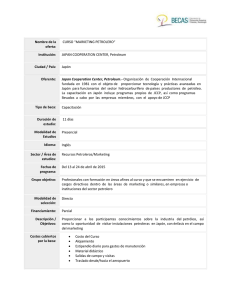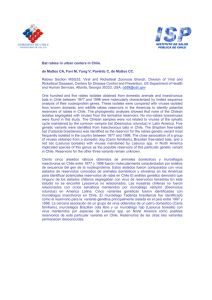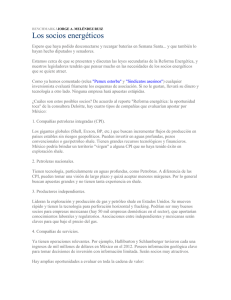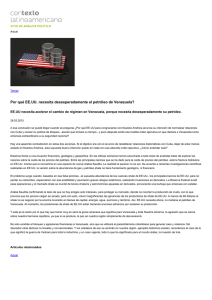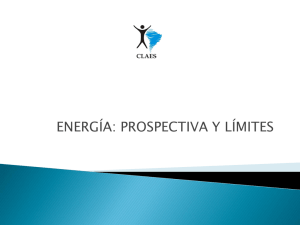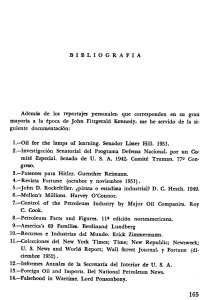EXPLOTACIÓN DE PETRÓLEO NO
Anuncio
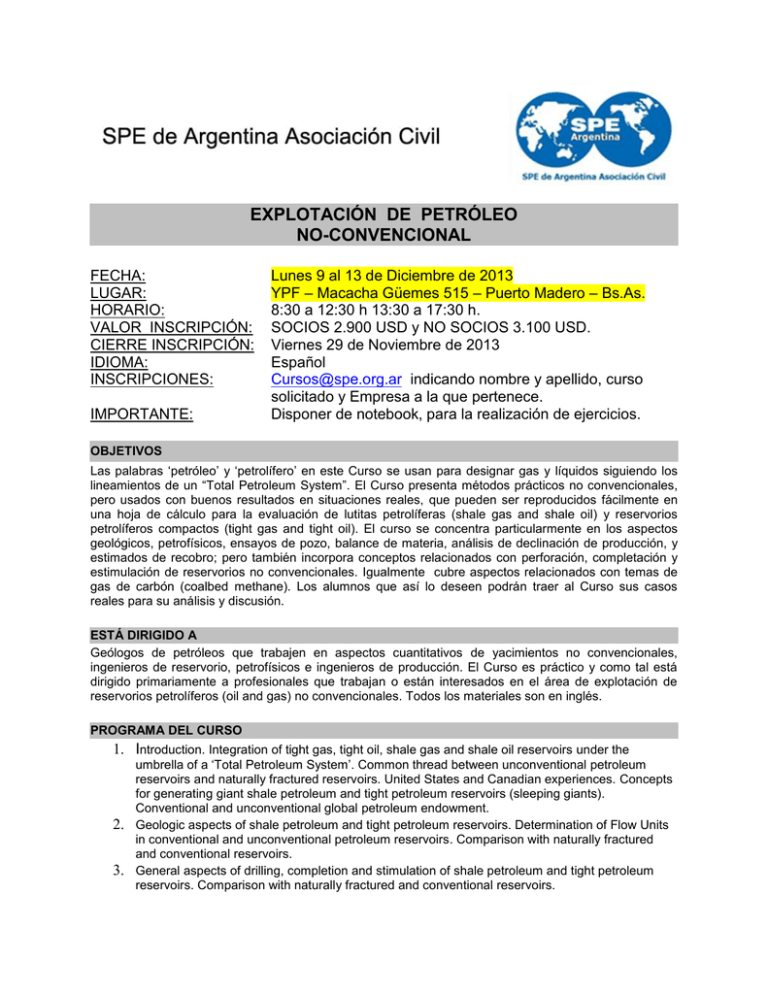
EXPLOTACIÓN DE PETRÓLEO NO-CONVENCIONAL FECHA: LUGAR: HORARIO: VALOR INSCRIPCIÓN: CIERRE INSCRIPCIÓN: IDIOMA: INSCRIPCIONES: IMPORTANTE: Lunes 9 al 13 de Diciembre de 2013 YPF – Macacha Güemes 515 – Puerto Madero – Bs.As. 8:30 a 12:30 h 13:30 a 17:30 h. SOCIOS 2.900 USD y NO SOCIOS 3.100 USD. Viernes 29 de Noviembre de 2013 Español [email protected] indicando nombre y apellido, curso solicitado y Empresa a la que pertenece. Disponer de notebook, para la realización de ejercicios. OBJETIVOS Las palabras ‘petróleo’ y ‘petrolífero’ en este Curso se usan para designar gas y líquidos siguiendo los lineamientos de un “Total Petroleum System”. El Curso presenta métodos prácticos no convencionales, pero usados con buenos resultados en situaciones reales, que pueden ser reproducidos fácilmente en una hoja de cálculo para la evaluación de lutitas petrolíferas (shale gas and shale oil) y reservorios petrolíferos compactos (tight gas and tight oil). El curso se concentra particularmente en los aspectos geológicos, petrofísicos, ensayos de pozo, balance de materia, análisis de declinación de producción, y estimados de recobro; pero también incorpora conceptos relacionados con perforación, completación y estimulación de reservorios no convencionales. Igualmente cubre aspectos relacionados con temas de gas de carbón (coalbed methane). Los alumnos que así lo deseen podrán traer al Curso sus casos reales para su análisis y discusión. ESTÁ DIRIGIDO A Geólogos de petróleos que trabajen en aspectos cuantitativos de yacimientos no convencionales, ingenieros de reservorio, petrofísicos e ingenieros de producción. El Curso es práctico y como tal está dirigido primariamente a profesionales que trabajan o están interesados en el área de explotación de reservorios petrolíferos (oil and gas) no convencionales. Todos los materiales son en inglés. PROGRAMA DEL CURSO 1. Introduction. Integration of tight gas, tight oil, shale gas and shale oil reservoirs under the 2. 3. umbrella of a ‘Total Petroleum System’. Common thread between unconventional petroleum reservoirs and naturally fractured reservoirs. United States and Canadian experiences. Concepts for generating giant shale petroleum and tight petroleum reservoirs (sleeping giants). Conventional and unconventional global petroleum endowment. Geologic aspects of shale petroleum and tight petroleum reservoirs. Determination of Flow Units in conventional and unconventional petroleum reservoirs. Comparison with naturally fractured and conventional reservoirs. General aspects of drilling, completion and stimulation of shale petroleum and tight petroleum reservoirs. Comparison with naturally fractured and conventional reservoirs. 4. Formation evaluation (petrophysics) of shale petroleum and tight petroleum reservoirs. Mineralogy effects. Use of single, dual, triple, quadruple porosity and quintuple porosity models. Use of Pickett plots for evaluation of porosity, water saturation, total organic carbon (TOC), level of organic metamorphism (LOM), diffusion and viscous flow, permeability, process speed, capillary pressure, height above free water table, pore throat aperture, grain size, and range of initial flow rates. Use of drill cuttings for complete quantitative formation evaluation and estimation of geomechanical properties in the absence of well logs. Comparison with naturally fractured and conventional reservoirs. 5. Formation evaluation (well testing) of tight petroleum and shale petroleum reservoirs. Use of single, dual, triple, quadruple and quintuple porosity models. Evaluations under radial and linear flow conditions without the need of specialized software (a few columns in a spread sheet provide the same results as complicated equations in Laplace space). Comparison with naturally fractured and conventional reservoirs. 6. Material balance for shale petroleum (oil and gas) and tight petroleum (oil and gas) reservoirs. Use of single, dual, triple, quadruple and quintuple porosity models. Viscous flow effect. Adsorption effect. Diffusion effect. Stress dependent reservoirs. Comparison with naturally fractured and conventional reservoirs. 7. Performance forecast and recovery from shale petroleum and tight petroleum reservoirs. Evaluations under radial and linear flow conditions without the need of specialized software. Comparison with naturally fractured and conventional reservoirs. Use of single, dual, triple, quadruple and quintuple porosity models. 8. General aspects of coal bed methane (CBM) reservoirs. Formation evaluation (petrophysics and well testing), performance forecast and recovery from CBM reservoirs. Differences and similarities with other unconventional gas reservoirs. CV DEL INSTRUCTOR Roberto Aguilera es profesor y ‘ConocoPhillips-NSERC-AERI Chair’ en la Escuela Schulich del Departamento de Ingeniería Química y Petróleos de la Universidad de Calgary, Canadá y presidente de Servipetrol Ltda en Calgary. Se graduó en ingeniería petrolera de la Universidad de América en Bogotá, Colombia y cuenta con Maestría y Doctorado en Ingeniería de Petróleo de la Escuela de Minas de Colorado (CSM). Ha sido instructor del AAPG en el tema de los yacimientos naturalmente fracturados. Ha dado conferencias y ha presentado su curso titulado yacimientos naturalmente fracturados y / o ha prestado servicios de consultoría en más de 50 países. Es un autor distinguido de la Revista de Tecnología Petrolera Canadiense (SPE JCPT, 1993 y 1999), galardonado con el premio Outstanding Service (1994) y la Medalla por Servicio Distinguido (2006) de la Sociedad de Petróleo de la CIM. Ha sido conferencista distinguido de la Sociedad de Ingenieros Petroleros (SPE) en yacimientos naturalmente fracturados para la temporada 2000-2001. Le fue conferido el premio de la SPE por Servicio Distinguido Regional en Facultades de Ingeniería de Petróleos en el año 2011. Es el creador de GFREE, un sistema de investigación y gerencia que incluye geoscience (G), formation evaluation (F), reservoir drilling, completion and stimulation (R), reservoir engineering (RE), and economics and externalities (EE).
